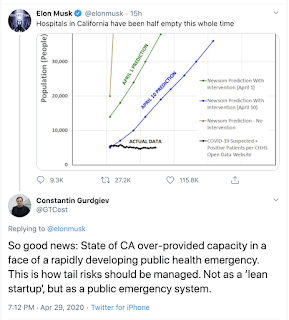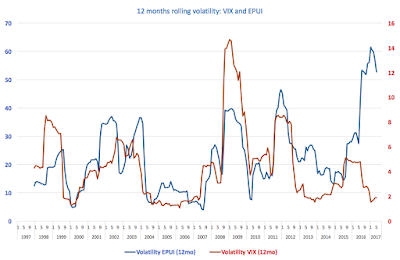I came across this very interesting, and to me - far reaching - paper on the effects of organizational structures on the organization's ability to cope with uncertainty and change. Karynne L. Turner, Mona V. Makhija. “Measuring what you know: an individual information processing perspective” (April 15, 2010). Atlanta Competitive Advantage Conference 2010 Paper (
here).
According to the information processing perspective, the organization’s ability to draw upon and utilize information is dependent on the relationship between structure and the ability of individuals to process information, facilitated by specific organizational aspects of the firm. The study considers the effect of two types of structure, organic (integrated or systemic) and mechanistic (siloed), on individuals’ ability to gather, interpret and synthesize information, and their problem-solving orientation. Evidence shows that individuals develop more information processing capability under organic than mechanistic structures, which in turn creates more problem solving orientation in individuals.
In short, the study lends support to the premise that better integrated, more diversified across skills and less siloed organizations produce more effective and efficient gathering, processing and interpreting of information, as well as better problem solving.
Effective management of knowledge is the basis of firms’ ability to compete (Zander and Kogut, 1995; Nonaka, 1994). This is achieved through organizational design (Teece at al., 1997) that underlies “the means by which firms acquire, disseminate, interpret and integrate organizational knowledge”.
Organizational structure embodies a number of key elements, such as control and coordination or management mechanisms, and human capital management that allocate tasks to work units and individuals, and coordinate them in a way that achieves organizational goals. The manner in which this is done is critical due to problems created by
- External uncertainty associated with suppliers, competitors and consumer demand (Gresov and Drazin, 1997; Sine, Mitsuhashi and Kirsch, 2006), or
- Internal uncertainty, due to the complexity of internal coordination, measurement difficulties and changing processes (Habib and Victor, 1991).
Uncertainty reduces the effectiveness of pre-established routines, technologies or goals, and increases the importance of problem solving (Becker and Baloff, 1969)). The more work related uncertainty increases, the greater the need there will be for information processing (Turner and Makhija, 2006 and Tushman, 1979).
One way in which an organization addresses uncertainty is by assigning specific responsibilities to specialized subunits, which collect, process and distribute information acting as “a set of nested systems” (Daft and Weick, 1984).
Literature distinguishes two types of organizational structures, mechanistic and organic. These structures differ in the distribution of tasks, the flow of information among individuals and across units, and the extent to which there is interaction with the environment (Shremata, 2000; Gibson and Birkinshaw, 2004).
Mechanistic forms of organization are characterized by hierarchical division of labor, in which communication tends to be in one direction – top to bottom. Individuals develop deep expertise in their own designated jobs, which tend to be clearly specified and specialized in individual knowledge. The mechanistic structures do not allow for much flexibility (Parthasarthy and Sethi, 1993).
Organic forms of organizations are based on horizontally-administered teams, in which all members participate in management decisions (Baum and Wally, 2003), allowing for worker autonomy, responsibilities adaptation. Team members developing competence across multiple tasks, thus diversifying their skills and knowledge sets. Individuals have broader unit-level knowledge rather than just one job and develop greater flexibility.
The structural differences between mechanistic and organic organizational forms are likely to influence the development of information processing capability in organizational members, reflected in organization’s ability to gather, interpret and synthesize information. Turner and Makhija (2010) consider the impact of different types of structures on each of these three aspects of organizational members’ information processing capability.
Turner and Makhija (2010) postulate a set of testable hypotheses all of which are confirmed:
H1: Organic structures lead to more gathering of information than mechanistic structures.
Implication: uncertainty is reduced in organic (integrated or more horizontal) structures through reduced information asymmetries vis-à-vis external environment.
H2: Organic structures lead to more similarly interpreted information than mechanistic structures.
Implication: information asymmetries are reduced across the broader range of the organization structures in the organic setting.
H3: Organic structures lead to more synthesized information than mechanistic structures.
Implication: organic systems are better capable of integrating information of various types.
H4: More gathering of information is associated with greater problem solving orientation.
Implication: organic systems are better able to cope with converting uncertainty into manageable risks systems.
H5: More similarly interpreted information is associated with greater problem solving orientation.
Implication: better information processing in organic systems results in better problem solving, so information is used more effectively.
H6: More synthesized knowledge is associated with greater problem solving orientation.
Implication: individuals also tended to synthesize, or understand the interrelationships among different types of information, much better than individuals working in mechanistic structures.
H7: Information processing capability mediates the relationship between organizational design and problem solving orientation
Implication: the effects of individuals’ information processing on their problem solving orientation is greater in the organic structures, reflecting their comfort with problem situations in their work.
Turner and Makhija (2010) research shows that, when operating in two different types of structures, individuals process information differently in all three respects: gathering, interpreting, and synthesizing information.
These findings have several far-reaching implications for the organizational structures found in Ireland.
Firstly, it is clear that hierarchical and fixed systems approach to public services provision – characterized by the lack of communications between vertically-integrated public sector departments and organizations leads to their inherently lower ability to absorb, process and implement informational processes that manage uncertainty.
Secondly, this shows why successful entrepreneurial ventures are horizontal in nature and less siloed.
Third, it shows that our political system – with disproportionate powers allocated to the executive, as opposed to more uniform distribution of powers between the executive, legislative and judiciary – is similarly to the public sector less equipped to handle uncertainty.































